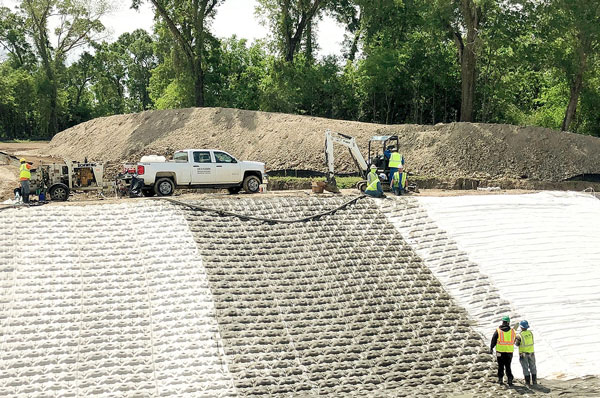Professional Solutions by Memphis Erosion Control Solutions excavation
Wiki Article
Best Practices for Disintegration Control in Construction Projects
Are you working on a building project and worried concerning erosion control? In this short article, we will lead you with the finest practices for preventing disintegration on your site. erosion control. Get ready to deal with erosion head-on and make certain the success of your building project.5 Crucial Disintegration Control Techniques

To successfully manage disintegration on your building website, you'll need to implement crucial methods such as incline stabilization and debris control steps. Incline stabilization is vital in avoiding dirt erosion on high inclines. You can accomplish this by using techniques like terracing, which involves producing straight steps on the slope to reduce water flow and advertise the absorption of rainwater. One more reliable method is making use of disintegration control coverings or mats, which are positioned on the incline and help preserve soil fragments while enabling vegetation to expand. Debris control steps are additionally essential to stop debris overflow right into neighboring water bodies. One efficient approach is the setup of silt fences along the boundary of the construction website. These fences act as obstacles, capturing sediment-laden water and permitting it to resolve before it gets to the water bodies. Additionally, you can utilize debris basins, which are short-lived retention fish ponds designed to trap debris and enable water to gradually drain off. Carrying out these important disintegration control techniques will help lessen the negative ecological effect of your building and construction project and ensure conformity with laws.
Effective Debris and Overflow Management

You can efficiently handle debris and drainage in your building and construction task by implementing proper erosion control steps. Sediment and runoff management is important to stop erosion and protect the surrounding environment. One effective measure is the installment of silt fencings along the border of the building and construction website. These fencings assist to include sediment and prevent it from entering nearby water bodies. An additional vital technique is the implementation of disintegration control coverings or floor coverings. These coverings supply a protective layer on bare dirt, minimizing the influence of rains and protecting against disintegration. Additionally, the use of debris containers or debris traps can aid to capture debris and prevent it from getting in stormwater systems. Regular maintenance of these steps is important to ensure their efficiency throughout the building task. This includes cleaning and checking sediment containers and regularly changing silt fences and disintegration control coverings as needed. By applying these erosion my explanation control measures, you can properly handle debris and overflow in your construction task, reducing the influence on the atmosphere and complying with governing demands.
Key Considerations for Incline Stablizing
You need to meticulously examine the slope's features, such as its composition, angle, and drain patterns. Look for signs of erosion, such as exposed origins, fractures, or down dirt.Another alternative is to grow vegetation on the slope, as the origins can assist anchor the soil and control disintegration. In addition, installing erosion control coverings or mats can provide prompt security while vegetation comes to be well established.
It's important to on a get redirected here regular basis keep track of the maintained inclines to ensure their efficiency. Maintain an eye out for any type of signs of activity or erosion, and take instant action if necessary. Regular maintenance, such as inspecting and repairing any broken actions, is additionally crucial to make certain long-term security.
Best Practices for Vegetation and Soil Protection
One effective way to shield plants and dirt on slopes is by consistently checking for indications of disintegration and taking prompt activity if needed. Start by inspecting the incline for any type of indications of disintegration, such as exposed origins, bare soil patches, or debris accumulation at the base. Implement erosion control actions such as mounting disintegration control coverings, mulching, or also building preserving walls if needed.Implementing Appropriate Water Drainage Systems
When it comes to managing water flow and avoiding erosion, recognizing these elements is necessary. Steeper inclines can lead to faster water circulation, boosting the risk of erosion and flooding. On the other hand, gentler slopes allow water to move much more gradually, reducing erosion potential.Sandy soils have a tendency to drain pipes faster due to their coarse appearance, while clay soils have a slower drain price due to their compact nature. In addition, thinking about the dirt characteristics assists prevent waterlogging, which can lead to inadequate plant development and damages to frameworks.
Conclusion
In verdict, when it comes to erosion control in building and construction tasks, you landscaping places near me must adhere to these ideal techniques. Consider slope stablizing approaches to guarantee the stability of the website. By following these vital methods, you can properly control disintegration and make sure the success of your construction project.To successfully control erosion on your building site, you'll need to execute important techniques such as incline stablizing and sediment control measures. Slope stabilization is essential in stopping dirt disintegration on high slopes. An additional effective method is the use of erosion control coverings or floor coverings, which are positioned on the slope and help preserve dirt particles while allowing greenery to expand. Another alternative is to plant vegetation on the incline, as the origins can assist anchor the soil and control erosion. Implement erosion control steps such as setting up erosion control blankets, mulching, or even constructing preserving walls if required.
Report this wiki page